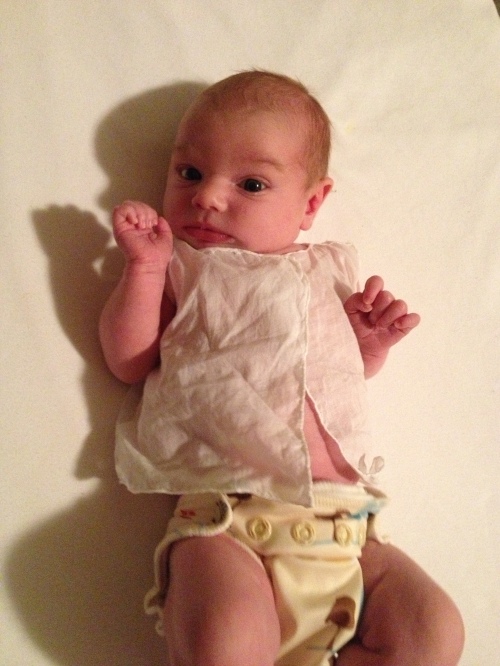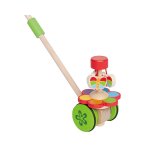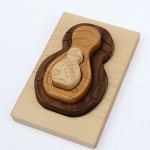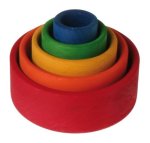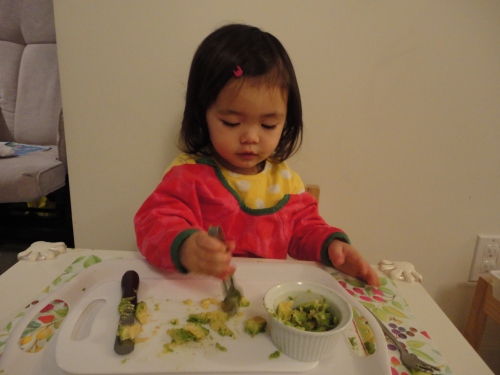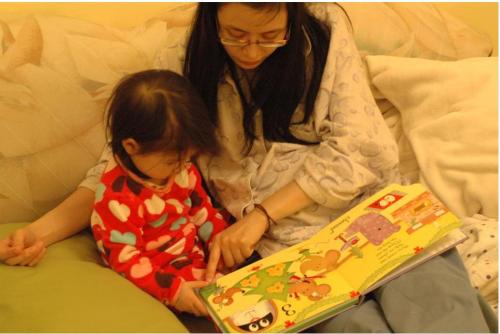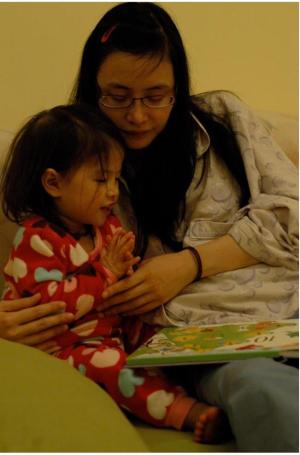By Rubi
Some of our blog’s readers expressed interest reading about clothing; since I love talking about movement I thought it would be interesting to share a paper I wrote a while ago when taking my Assistant to Infancy training. I also wanted to see if my ideas had changed after I had a baby, to my surprised I feel exactly the same way as I did before.
Movement
Maria Montessori explained that Humans have a tendency for movement. Indeed this movement begins in the womb, (humans have an inclination, a need, a strong desire to move and explore, movement is hardwired into them, and they are born with it.) Babies, in fact, spend nearly half of their waking time moving, either kicking, bouncing, or waving their arms, crawling, standing, etc. While it may appear all this activity is just for the sake of moving, it’s important to realize a baby is never “just moving” or “just playing.” Every action extends the child’s development in some way, this movement could be voluntary or involuntary, it doesn’t really matter they need to move in order to continuing wiring their brain. Repetition of movement is one of the keys for healthy brain development.
 “In order to develop his mind a child must have objects in his environment which he can hear and see. Since he must develop himself through his movement, through the work of his hands, he has need of objects with which he can work that provide motivation for his activity.” (Maria Montessori, The Secret of Childhood, pg. 82)
“In order to develop his mind a child must have objects in his environment which he can hear and see. Since he must develop himself through his movement, through the work of his hands, he has need of objects with which he can work that provide motivation for his activity.” (Maria Montessori, The Secret of Childhood, pg. 82)
Thanks to new insights in brain research, we now know that early movement experiences are considered essential to the neural stimulation (the “use-it-or-lose-it” principle involved in the keeping or pruning of brain cells) needed for healthy brain development.
Not long ago, neuroscientists believed that the structure of a human brain was genetically determined at birth. They now realize that although the main “circuits” are “prewired” (for such functions as breathing and the heartbeat), the experiences that fill each child’s days are what actually determine the brain’s ultimate design and the nature and extent of that child’s adult capabilities.
Neurophysiologist Carla Hannaford, in her book, Smart Moves: Why Learning Is Not All in Your Head, states: “Physical movement, from earliest infancy and throughout our lives, plays an important role in the creation of nerve cell networks which are actually the essence of learning.” She then goes on to relate how movement, because it activates the neural wiring throughout the body, makes the entire body not just the brain the instrument of learning.
 “…the development of movement is found to be connected with sight. The first step in movement is that of grasping or prehension; as soon as the hand grasps something, consciousness is called to the hand, and prehension is developed, that which was at first instinctive becoming a conscious movement. At six months it is fully intentional. At ten months, observation of the environment has awakened the interest of the child, and he wants to catch hold of everything, so prehension is now accompanies by desire. He begins to exercise the hand by changing the places of things around him, by opening and shutting doors, pulling out drawers, putting stoppers in bottles, and so on. Through these exercises, he acquires ability.” (Maria Montessori, Education for a New World, pg. 42)
“…the development of movement is found to be connected with sight. The first step in movement is that of grasping or prehension; as soon as the hand grasps something, consciousness is called to the hand, and prehension is developed, that which was at first instinctive becoming a conscious movement. At six months it is fully intentional. At ten months, observation of the environment has awakened the interest of the child, and he wants to catch hold of everything, so prehension is now accompanies by desire. He begins to exercise the hand by changing the places of things around him, by opening and shutting doors, pulling out drawers, putting stoppers in bottles, and so on. Through these exercises, he acquires ability.” (Maria Montessori, Education for a New World, pg. 42)
What else does movement do? Movement contributes to children’s fine and gross motor development, builds physical strength and stamina, enhances perceptual motor skills, attention span, improves circulation, and helps maintain muscle tone and thus postural control, etc. Now we know all the things infants and children are missing when they are being held by the adult or being confined in a crib, play pen, bouncer, car seat, carrier, stroller, bouncer, walker, exersaucer, or something as simple as wearing the clothing that restricts their movement.
Restriction of Movement
Continual restriction of a child’s movement may have negative consequences for the child’s motor and cognitive and emotional development in later years. For instance if the baby cannot crawl to the toy she or he sees across the room, s/he tent to forget about it. If s/he forgets about it, s/he cannot explore its shape, texture and shape. In short if s/he cannot physically explore something, then s/he is not engaging his/her mind to learn about it. Children cannot take the information from the environment just by looking at it. In order to absorb information, young children need to hear, look, at, move toward, touch, and feel all the various stimuli. Maria Montessori called the child during the first three years of life “The Sensorial Explorer”
 Tara Losquadro writes in her book Why Motor Skills Matter, “When parents provide an environment full of possibilities and understand the basic principles of physical development, they can enhance their child’s gross and fine motor skills and his speech development, among other things, In turn; these enhancements benefit the child’s emotional well-being and the development of higher self-esteem. With higher self-esteem comes a greater ability to take charge of situations, and to thus feel more secure.” We need to provide them with different sensorial experiences always remembering to provide the right amount of stimuli, never too much because this would cause over stimulation.
Tara Losquadro writes in her book Why Motor Skills Matter, “When parents provide an environment full of possibilities and understand the basic principles of physical development, they can enhance their child’s gross and fine motor skills and his speech development, among other things, In turn; these enhancements benefit the child’s emotional well-being and the development of higher self-esteem. With higher self-esteem comes a greater ability to take charge of situations, and to thus feel more secure.” We need to provide them with different sensorial experiences always remembering to provide the right amount of stimuli, never too much because this would cause over stimulation.
Still, recent evidence indicates that infants are spending upward a large amount of waking hours a week in things like high chairs, carriers, car seats. The reasons for this trend are varied. From what I have observed, part of the problem is that infants in some childcare centers; where there may not be enough space to let babies roam the floor. Or, given the number of infants enrolled, there may be little opportunity for caregivers to spend one-on-one time with each baby. This means, in the morning, an infant is typically fed, dressed, and then carried to the automobile, where she’s placed in a car seat. She’s then carried into the childcare center, where she may spend much of her time in a crib or playpen. At the end of the day, she’s picked up, placed again into the car seat, and carried back into the house, where she’s fed, bathed, and put to bed.
Clothing: Why is clothing so important when babies or toddlers move?
Clothing may restrict the child’s movement when extending his/her arm, practicing batting, reaching movements, crawling, walking and movement in general, even lessening the child’s desire to move. The child when moving a specific part of his/her body is being restrained by a piece of material, and s/he assimilates that piece of material as his/her own ability to extend his/her limbs, or his/her own ability to move. It’s important that we choose clothing for our children that is comfortable to wear, appropriate to the environment they will be in, age appropriate and designed to accommodate their greatest variety of movement. It must also be the right size. Hand me downs can be great but if they are too big or too small they might thwart the natural movement of the child or encourage bad habits and posture. A friend gave me an example of this when she was looking after a 7 year old. The pants were too big, always falling down, the boy consistently pulled them up, tripped over them, underwear exposed, etc. He is a very active child and has the necessity to move. Wearing this type of clothing can be dangerous and also draw continuous or negative attention from adults; because of these inadequacies his self-esteem and desire to move may be affected.
What is it that parents look for when buying baby clothes? Is it appearance; is it durability, aesthetics, price, brands, trends, fabrics, fashion, personal style or all of the above?

Examples of clothing that allow for movement
I have only one request for you, when looking for baby clothing try to image yourself in that specific piece of clothing and think how functional or practical it is going to be wearing that piece of garment all day long, including visits to the bathroom. See if it feels comfortable when moving arms, legs, stretching, bending, crawling, etc. If it is too tight or too loose, that you may fall down if you step on it, is it easy to put it on and take it off, how long would it take for you to put it on and take it off, what kind of clothing aids in freedom of movement (this is if we want to encourage independence in toddlers). Young children like to be independent and try to dress and undress independently, don’t kill the desire to do it by buying clothes with complicated fastenings. Try to use clothing that is easy to slip on, pull in and out and stretches when take it off.
Remember people who make baby clothes are not necessarily childhood development specialist; they are designing clothes that catches the eye of the adult, so next time you go baby clothing shopping take into consideration the importance of movement development and its consequences. What is more important, being in style or being able to move?
My Experience with my Daughter
Here are some pictures of F wearing clothing that in my opinion allows her to move freely. I love seeing my daughter in little dresses but she can’t really crawl or move in them, so I’ve decided to wait until she is older to wear them if she wants to. If she really has to wear a dress for a special occasion (e.g. wedding) I tuck the dress in her pants so she doesn’t trip when crawling or pulling to stand up.


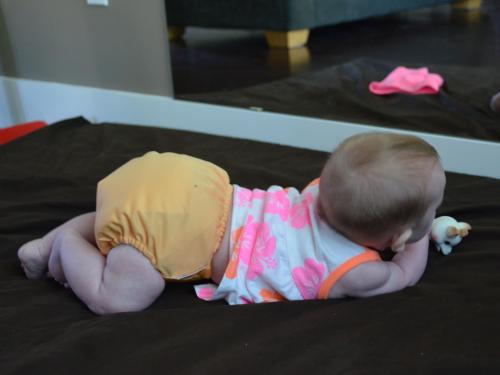
 A whole lot less garbage created, cute cloth diaper bum, economical, and minimal extra effort has made cloth diapering a great choice for us!
A whole lot less garbage created, cute cloth diaper bum, economical, and minimal extra effort has made cloth diapering a great choice for us!
